Salt and Sodium
Understanding Salt and Sodium:
Sodium is one of life’s essential minerals. We need sodium in our diets to help regulate of kidneys and help to balance our body’s fluid balance. Sodium also helps to send nerve impulses, helps our muscles function (relax/contract) and maintains a balance of water and minerals. As our body’s need sodium to function this is often the reason why we crave it.
We find Salt in almost all foods we eat as it acts as a stabilizer. As well as this it also helps to preserve our food with the presence of bacteria.
For our bodies to function it is estimated that we should consume around 500 mg of sodium daily. Sadly, like most things we can often overconsume salt which leads to strokes, heart disease and high blood pressure.
While we often say that salt and sodium are the same, there is a difference between the two. Salt is the most readily available and concentrated form of sodium on earth. Understanding the differences is important when making choices about your diet and health.
What is salt?
When we mention salt, we often think of table salt, the salt we add to our foods before consuming or cooking. Table salt is sodium chloride (NaCI), it is roughly 40% sodium and 60% chloride by its weight. We harvest our table salt from various places such as:
- Salt mines (from seabed’s that dries up many years ago)
- Evaporating sea water
- Other mineral rich waters
As we know, flavoring and food preservation are salts 2 main functions.
There are 4 common salts that we may see at our supermarket:
- Table salt – this contains iodine, (iodine is an important mineral that we often lack in our diets) We roughly need 150 mcg of iodine daily.
- Sea salt – this comes from the ocean, sea salt is known to be more natural, sea salt granules are larger, less refined and more course. It often includes more minerals, such as potassium, zinc, and iron. It is important to note that sea salt is containing more and more microplastic residue because of its increasing growth in our oceans.
- Himalayan Pink salt – this salt that is more course and pale pink in color comes from Pakistan. Himalayan Pink salt contains small traces of potassium, iron, calcium, and magnesium. While you may think it is better to consume pink salt it only contains small amounts of essential minerals which you can get from eating food. It also has other environmental concerns, it is non-renewable, finite resource and requires many green-house gas food miles to reach global consumers.
- Kosher salt – this salt is often used for Jewish cooking. Its texture is larger and flakier compared to its other counterparts. Kosher salt however does not contain iodine, it is perfect for removing moister from meat cooked in the koshering process.
What is Sodium?
Sodium is a naturally occurring mineral that is often added during the manducating process of foods. Sodium is an electrolyte, which means it holds an electric charge when it is dissolved in our bodily fluids.
It is estimated that 90% of the food we consume daily has a percentage of 90% sodium and 10% of the food we consume comes from other sodium sources like baking soda and sodium bicarbonate.
The sodium in our bodies is usually found in our blood and the fluid surrounding our cells. It is very important in our bodies and aids in maintaining our nerve and relaxing/contracting our muscles. When the sodium you eat and sodium you excrete aren’t balanced then this leads to imbalances in our bodies which then leads to health problems.
How much sodium do we need?
The recommended dietary guideline for sodium intake:
Adults = 150 mcg a day
Children (up to the age of 8) = 90 mcg
Pregnant females = 220 mcg a day
***

*DISCLAIMER: Please consult your GP before making any changes to your diet, this page is just information to help assist and give you some basic nutrition knowledge.
References:
ISSA Nutritionist Course
Food Revolution Network, saltvssodium debate
Harvard T.H Chan, School of Public Health



